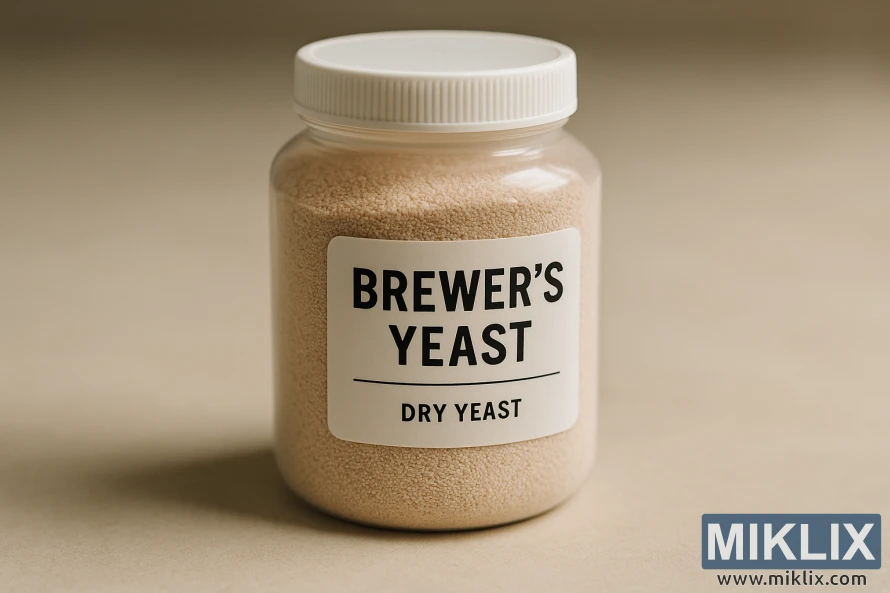Image: Sealed Dry Brewer’s Yeast on Neutral Background
Published: October 6, 2025 at 4:07:22 PM UTC
High-resolution close-up of a sealed container of dry brewer’s yeast on a neutral surface. Soft, diffused light highlights clean labeling, fine granules, and proper storage for reliable fermentation.
A clean, minimalist still life centers on a sealed plastic container of dry brewer’s yeast placed on a neutral, matte surface. The container sits dead-center in the frame, very slightly angled to the right so both its cylindrical form and front label are legible. It has a white, ribbed screw-top lid that catches a soft strip of highlight along its rim, signaling an airtight seal. The body of the container is smooth and gently reflective; through it you can see a densely packed mass of pale beige granules. Each granule is tiny and rounded, forming an even, gently undulating texture that hints at the material’s uniformity and freshness. The granularity is especially noticeable near the front shoulder of the container, where the light rakes across the surface and creates delicate micro-shadows between the particles.
The label is simple, modern, and purposeful: bold, high-contrast typography reads “Brewer’s Yeast” with a secondary line “Dry Yeast,” separated by a thin rule. The label’s white background matches the lid and keeps the overall palette restrained and professional. There are no decorative flourishes—only functional design choices that communicate clarity and accuracy. The alignment is straight and the corners are softly rounded, mirroring the jar’s contours. Together, lid, label, and vessel form a cohesive design language of cleanliness, order, and dependable storage.
Lighting is diffused and even, coming from the upper left. It produces soft, wraparound illumination, gentle highlights on the lid and the label, and a muted, feathered shadow that falls to the left and slightly toward the viewer. The shadow is low-contrast and unobtrusive, grounding the container without competing for attention. Because the light is soft, the container’s faint reflections are velvety rather than crisp; this keeps the focus on form and texture rather than on glare. The exposure is balanced so the whites of the lid and label retain detail, while the beige of the yeast remains warm and natural.
The background is deliberately blurred and tonally close to the tabletop—warm gray-beige, smooth, and free from distractions. There are no visible seams or props; the gradient from slightly darker foreground to softer midground gives a quiet sense of depth. This restrained setup isolates the subject and underscores a product-photography aesthetic aimed at documentation and inspection. The composition uses a shallow depth of field to ensure the container’s front plane and label are crisp while everything behind falls into a calm bokeh.
Despite its simplicity, the photograph conveys a narrative about proper handling and storage. The container looks newly filled and firmly sealed, suggesting freshness and protection from moisture, oxygen, and contaminants. The neat label and the dust-free surface imply a workflow that values traceability and hygiene—key to consistent fermentation outcomes. The scene does not attempt theatricality; instead, it communicates reliability and readiness. You can imagine this container moving seamlessly from storage to bench to scale, then back to cold storage after precise weighing.
Color remains intentionally quiet: whites and warm neutrals dominate, punctuated by the soft beige of the yeast. This restrained palette reinforces a clinical-but-approachable mood often associated with home labs and careful craft processes. The overall effect is one of tidy control—an image that could just as easily live in a brewer’s standard operating procedures as in an equipment catalog—reminding the viewer that reliable fermentation begins long before pitching, with correct packaging, storage, and handling of the yeast itself.
The image is related to: Fermenting Beer with Mangrove Jack's M29 French Saison Yeast

